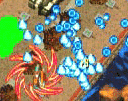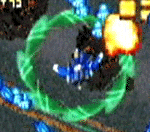|
MARS
MATRIX - TAKUMI - DREAMCAST
Reviewed by
Louis Gorenfeld
After GigaWing,
I didnít expect much from Mars Matrix. GigaWing was of the quarter-sucking
school of game design, which, while is fine in the arcades (if
you donít mind losing money), doesnít exactly translate to a good
home game. Mars Matrix is related to GigaWing somewhat; that is,
they both have a reflect shot weapon, have tons of objects on
the screen at once, have hugely inflated scores, are both horizontal-friendly
vertical shooters (you wonít break any TV sets playing them),
both run on CPS2 hardware at the arcade, and are by the same developer.
But the similarities end there (besides genre conventions of course).
 Mars
Matrix offers six hard levels of relentless bullet storms. While
initially the game looks to be impossible, the player soon realizes
that a degree of strategy and planning is what it takes to conquer
this game-- not inserting an endless supply of credits (though
that doesnít hurt). More specifically, it takes careful use of
your craftís four methods of dealing electric death. Mars
Matrix offers six hard levels of relentless bullet storms. While
initially the game looks to be impossible, the player soon realizes
that a degree of strategy and planning is what it takes to conquer
this game-- not inserting an endless supply of credits (though
that doesnít hurt). More specifically, it takes careful use of
your craftís four methods of dealing electric death.
 Even
though the playerís ship is equipped with so many weapons, the
controls couldnít be simpler. In fact, the game only uses one
button. This is how it works: Tap the button to use a destructive
short range blast (Piercing Cannon), press it continually for
long-range rapid fire (either spread or laser pattern depending
on the ship), hold it down to suck in enemy bullets and spit them
back out (Absorption Barrier Mosquito, which also doubles as a
short range weapon), and hold it down until your meterís drained
to unleash a bomb that destroys many objects on screen at a time--
but leaves the ship vulnerable as the charge meter fills (Gravity
Hole Bomb). The trade-off between longer relief from enemy fire
(which drains your meter) or having it available sooner makes
for intense split-second desicion making since the longer you
hold down the button, the longer it is before you can use your
Absorption Barrier. The only downside of this control scheme is
a tiny moment of lag when using this weapon. Some consider having
to anticipate using the Absorption Barrier in advance a design
flaw, though I like to think of it as part of the challenge. Even
though the playerís ship is equipped with so many weapons, the
controls couldnít be simpler. In fact, the game only uses one
button. This is how it works: Tap the button to use a destructive
short range blast (Piercing Cannon), press it continually for
long-range rapid fire (either spread or laser pattern depending
on the ship), hold it down to suck in enemy bullets and spit them
back out (Absorption Barrier Mosquito, which also doubles as a
short range weapon), and hold it down until your meterís drained
to unleash a bomb that destroys many objects on screen at a time--
but leaves the ship vulnerable as the charge meter fills (Gravity
Hole Bomb). The trade-off between longer relief from enemy fire
(which drains your meter) or having it available sooner makes
for intense split-second desicion making since the longer you
hold down the button, the longer it is before you can use your
Absorption Barrier. The only downside of this control scheme is
a tiny moment of lag when using this weapon. Some consider having
to anticipate using the Absorption Barrier in advance a design
flaw, though I like to think of it as part of the challenge.
 If the
strategic use of weapons isnít enough to keep you busy, Mars Matrix
uses a level-up power system in which you collect experience cubes.
When you collect enough of them, your shipís weapon gets more
powerful and you Ďlevel upí. Itís not as easy as it looks, especially
since your experience points increase exponentially. When a cube
is collected, it boosts a multiplier meter. As long as this meter
is somewhat full, each cube collected increases the value of each
subsequent cube collected. This encourages the player to fly madly
between shots trying to collect cubes before the multiplier meter
runs out in order to gain score and firepower-- one of the most
fun aspects of the game. If the
strategic use of weapons isnít enough to keep you busy, Mars Matrix
uses a level-up power system in which you collect experience cubes.
When you collect enough of them, your shipís weapon gets more
powerful and you Ďlevel upí. Itís not as easy as it looks, especially
since your experience points increase exponentially. When a cube
is collected, it boosts a multiplier meter. As long as this meter
is somewhat full, each cube collected increases the value of each
subsequent cube collected. This encourages the player to fly madly
between shots trying to collect cubes before the multiplier meter
runs out in order to gain score and firepower-- one of the most
fun aspects of the game.
The gameplay is pretty hectic. Most of the shots donít move very
quickly, but there are so many of the colored, patterned bullets
that it makes the Dreamcast slow down at times. Occasionally,
some of the shot patterns are so complex and the manuvering required
to avoid them so precise that the game becomes tedious (most notably
some of the boss encounters). Fortunately, most of the game is
designed rather thoughtfully and seems to slowly complicate the
level as it goes on instead of throwing everything at the player
all at once. For example, in Level 3, just when youíre getting
used to one of the shot patterns, turrets pop up and add another
layer to the challenge. In addition, each level has a distinct
personality, usually with very different enemy patterns. I should
probably point out at this time that if you are easily frusterated,
you may want to stay away from this game. Though it doesnít feel
unfair or like itís a quarter-muncher (like some other shooters
I could mention), it is a hard game. Itís nothing practice wonít
cure though.
Like any good home port, it gives the player more than just the
arcade mode. Extra unlockable features (purchased with score earned
in the game) are available, including alternate enemy patterns
(which makes it play almost like a whole different game), a score
challenge mode (unlimited lives given in order to rack up the
highest score on a given level), tweakable player ship rules,
an art gallery, and one of the best features: a strategy mode
in which you can view a movie of how to play through the levels
to get the highest score, uncover secrets-- all without losing
a life (easier watched than imitated).
 However,
every game is not without its problems. The graphics of Mars Matrix
are a mixed bag. Some of them are very good: the fleet of ships
among the coulds in the beginning of Level 2 stand out. But some
of the spritesí edges look too dark and donít seem to mesh with
the background right. Most graphics in the game lack color, with
gray and shades of brown being the main background colors throughout
most of the levels. As in GigaWing, the graphics are stretched
to fit the Dreamcastís screen mode, which causes slight ripples
as the game scrolls. If the screen height in the game is set to
448, at least it wonít ripple vertically (and the graphics look
much better this way). However,
every game is not without its problems. The graphics of Mars Matrix
are a mixed bag. Some of them are very good: the fleet of ships
among the coulds in the beginning of Level 2 stand out. But some
of the spritesí edges look too dark and donít seem to mesh with
the background right. Most graphics in the game lack color, with
gray and shades of brown being the main background colors throughout
most of the levels. As in GigaWing, the graphics are stretched
to fit the Dreamcastís screen mode, which causes slight ripples
as the game scrolls. If the screen height in the game is set to
448, at least it wonít ripple vertically (and the graphics look
much better this way).
Mars Matrixís music has more problems than the graphics, consisiting
mostly of unmemorable techno grooves, with little I would want
to listen to away from the game. But much in the same way that
the background is obscured by bright blue and pink bullets, the
music is drowned out by the loud, and good, gun and explosion
sound effects.
Though the audio and visuals wonít floor you, Mars Matrix offers
solid, addictive gameplay. Not only did Takumi do an excellent
job with this game, but Capcom had the guts to release it in the
U.S. Arcade game fans should ask themselves: ďHow often does this
happen?Ē
 Thanks Louis! Lovely review there.
Thanks Louis! Lovely review there.
Yep, it would seem that Capcom are puttling out all the stops
to bring shooties to the masses, what with their many collaborations
with Takumi, Cave and Psikyo, and some of the games brought out
are excellent works of art. Mars Matrix is one of Takumi's
better games, being a few million steps up from the two Gigawing
games, making great use of the reflect weapon and serious firepower.
Like Dodonpachi and Feveron, this game pioneers insane
blasting and collectivity, as well as constant score beating.
Get while you can! - Felix the Cat

|















